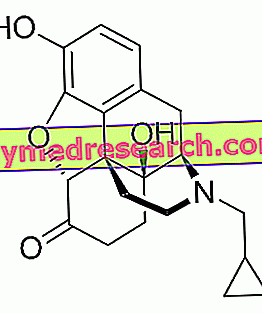Definition
Psoriatic arthritis is a chronic inflammatory disease that affects the joints and appears in individuals already suffering from psoriasis.
This disease can affect any joint in the body, although it often occurs at the ends of the fingers near the nail.
Psoriatic arthritis can be divided into different categories, depending on the joints involved.
Causes
The exact cause of psoriatic arthritis is not yet known. However, it seems that at the base of this pathology there is an autoimmune response towards its joints in individuals who already possess a certain genetic predisposition. Furthermore, the family component also appears to play a role in the development of the disease.
The risk factors that can favor the appearance of psoriatic arthritis, on the other hand, can be environmental, or trauma, infection, surgery, etc.
Symptoms
In individuals with psoriatic arthritis symptoms such as pain, swelling and / or joint stiffness, fatigue, tendinitis, bursitis, enthesitis, talalgie, reduction of movements, alterations of the nails, headaches and conjunctivitis can occur.
Information on Psoriatic Arthritis - Psoriatic Arthritis Drugs is not intended to replace the direct relationship between health professional and patient. Always consult your doctor and / or specialist before taking Psoriatic Arthritis - Psoriatic Arthritis Drugs.
drugs
The pharmacological treatment that can be undertaken against psoriatic arthritis is aimed, essentially, at controlling the symptoms induced by the disease and preventing their deterioration.
Naturally, the type of therapeutic strategy that the doctor decides to undertake varies according to the form of psoriatic arthritis that one suffers from, its severity and the patient's response to the therapy itself.
The milder forms can be kept under control by the administration of non-steroidal anti-inflammatory drugs (NSAIDs). Alternatively, disease-modifying antirheumatic drugs (DMARDs) or biological response modifiers (MRDs) can be used.
In some cases, moreover, the doctor could also decide to resort to intra-articular corticosteroid infiltrations.
Surgery is used only when there is a need to replace joints severely damaged by the disease.
Furthermore, it should be remembered that in individuals suffering from psoriatic arthritis, physical activity is very important to prevent the onset of joint stiffness and muscle weakness. Along with regular motor activity, it is also essential to adopt a healthy lifestyle.

NSAIDs
Thanks to their anti-inflammatory and analgesic properties, NSAIDs can be useful in controlling the milder forms of psoriatic arthritis.
Among the various active ingredients that can be used, we recall:
- Ibuprofen (Brufen ®, Moment ®, Nurofen ®, Arfen ®, Actigrip fever and pain ®, Vicks fever and pain ®): when administered orally, the dose of ibuprofen used should not exceed 1, 200-1, 800 mg of active ingredient per day. The most suitable dose for each patient will be established by the doctor.
- Naproxen (Momendol ®, Synflex ®, Xenar ®): when naproxen is administered orally, the usual dose is 500-1, 000 mg of drug per day, to be taken in divided doses every 12 hours.
- Diclofenac (Dicloreum ®, Deflamat ®): the dose of diclofenac usually administered orally is 75-150 mg per day, to be administered in divided doses.
- Indomethacin (Indoxen ®, Liometacen ®): if indomethacin is administered orally or rectally, the usual starting dose is 75 mg of drug per day. Later, your doctor may increase the above dose up to a maximum of 100-200 mg of active ingredient per day.
If, on the other hand, indomethacin is administered intravenously, the amount of drug usually used is 20-25 mg.
Disease-modifying antirheumatic (DMARD)
In the most serious cases of psoriatic arthritis and / or in the case in which the treatment with NSAIDs has proved ineffective, the doctor may decide to prescribe antirheumatic drugs modifying the disease. This category of medicines includes several active ingredients (chemically unrelated to each other) whose purpose is to slow down the progression of the disease.
Among these active ingredients, we recall:
- Ciclosporin (Ciqorin ®, Sandimmun ®): is an immunosuppressive drug available in different pharmaceutical formulations suitable for different routes of administration, including oral and parenteral administration. The exact amount of ciclosporin to be used must be established by the physician on an individual basis for each patient.
- Methotrexate (Reumaflex ®): methotrexate is available for intramuscular, subcutaneous and intravenous administration. The drug can only be administered by a doctor or a specialist. The dose usually used is 50 mg a week, to be taken for a period of 4-8 weeks.
- Sulfasalazine (Salazopyrin ®): the initial dose of sulfasalazine usually administered is 500 mg a day. Subsequently, the amount of drug used will be gradually increased until the optimal maintenance dosage for each patient is reached.
- Leflunomide (Leflunomide Winthrop ®, Arava ®, Leflunomide Medac ®, Leflunomide Teva ®, Repso ®): leflunomide is available for oral administration. Usually, the initial dose of drug used is 100 mg, to be taken the first three days of treatment. The maintenance dose usually administered for the treatment of psoriatic arthritis, on the other hand, is 20 mg a day.
Biological response modifiers (MRB)
The biological response modifiers used in the treatment of psoriatic arthritis are inhibitors of TNF-α (ie, tumor necrosis factor human α).
These drugs are administered parenterally only under the supervision of a doctor who specializes in using this type of medicine.
Usually, biological response modifiers are used if DMARD therapy has been shown to be ineffective.
Among the various drugs that can be used, we recall:
- Infliximab (Inflectra ®, Remicade ®, Remsima ®): is a monoclonal antibody that is usually administered at a dose of 3-5 mg / kg of body weight. The frequency of administration and the duration of treatment depend on the severity of the disease and the patient's response to the same treatment.
- Adalimumab (Humira ®): Adalimumab is also a monoclonal antibody. When used in the treatment of psoriatic arthritis, the usual adalimumab dose is 40 mg, to be administered subcutaneously every other week.
- Golimumab (Simponi ®): golimumab is another monoclonal antibody that is used in the therapy of psoriatic arthritis. The dose of medication usually used is 50 mg of active ingredient, to be administered once a month by subcutaneous injection.
- Etanercept (Enbrel ®): unlike the other medicines described above, etanercept is not a monoclonal antibody, but a biological medicine obtained with recombinant DNA techniques.
The dose of medication usually used in the treatment of psoriatic arthritis is 25 mg, to be administered by subcutaneous injection twice a week. Alternatively, 50 mg of active ingredient can be administered only once a week.
However, the aforementioned medicine dosage can be modified by the doctor, to better adapt it to the needs of each individual patient.
Corticosteroids
Sometimes the doctor may decide to resort to temporary treatment with corticosteroids via the intra-articular route. In fact, these medicines are powerful anti-inflammatories that can be useful in the treatment of psoriatic arthritis. However, their administration by intra-articular route is an extremely delicate operation that must be carried out only by specialized personnel, since there is the risk of causing damage, or worse, rupture of the tendons present at the joint.
Among the various corticosteroids that can be used for this purpose, we recall Methylprednisolone (Depo-Medrol ®, Depo-Medrol + Lidocaine ®). Methylprednisolone is available for intra-articular administration in pharmaceutical formulations either alone or in combination with lidocaine (a local anesthetic). When administered by this route, the dose of drug used can range from 4 mg to 80 mg of active ingredient. The exact amount of medicine to be administered will be established by the doctor, depending on the affected joint and the severity of the disease.



